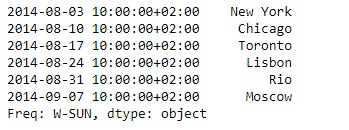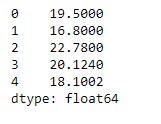Pandas 係列是帶有軸標簽的一維ndarray。標簽不必是唯一的,但必須是可哈希的類型。該對象同時支持基於整數和基於標簽的索引,並提供了許多方法來執行涉及索引的操作。
Pandas Series.to_string()函數呈現Series的字符串表示形式。
用法: Series.to_string(buf=None, na_rep=’NaN’, float_format=None, header=True, index=True, length=False, dtype=False, name=False, max_rows=None)
參數:
buf:寫入緩衝區
na_rep:要使用的NAN的字符串表示形式,默認為“ NaN”
float_format:格式化程序函數,如果列為浮點數元素,則應用於列的元素默認為None
header:添加係列標題(索引名稱)
index:添加索引(行)標簽,默認為True
length:添加係列長度
dtype:添加Series dtype
name:如果不是,則添加係列名稱
max_rows:截斷前要顯示的最大行數。
返回:格式化的字符串。
範例1:采用Series.to_string()函數呈現給定係列對象的字符串表示形式。
# importing pandas as pd
import pandas as pd
# Creating the Series
sr = pd.Series(['New York', 'Chicago', 'Toronto', 'Lisbon', 'Rio', 'Moscow'])
# Create the Datetime Index
didx = pd.DatetimeIndex(start ='2014-08-01 10:00', freq ='W',
periods = 6, tz = 'Europe/Berlin')
# set the index
sr.index = didx
# Print the series
print(sr)輸出:

現在我們將使用Series.to_string()函數將字符串表示形式呈現給此係列對象。
# render to string form
sr.to_string()輸出:

正如我們在輸出中看到的,Series.to_string()函數已成功將字符串表示形式呈現給定對象。
範例2:采用Series.to_string()函數呈現給定係列對象的字符串表示形式。
# importing pandas as pd
import pandas as pd
# Creating the Series
sr = pd.Series([19.5, 16.8, 22.78, 20.124, 18.1002])
# Print the series
print(sr)輸出:

現在我們將使用Series.to_string()函數將字符串表示形式呈現給此係列對象。
# render to string form
sr.to_string()輸出:

正如我們在輸出中看到的,Series.to_string()函數已成功將字符串表示形式呈現給定對象。
相關用法
- Python pandas.map()用法及代碼示例
- Python Pandas Series.str.len()用法及代碼示例
- Python Pandas.factorize()用法及代碼示例
- Python Pandas TimedeltaIndex.name用法及代碼示例
- Python Pandas dataframe.ne()用法及代碼示例
- Python Pandas Series.between()用法及代碼示例
- Python Pandas DataFrame.where()用法及代碼示例
- Python Pandas Series.add()用法及代碼示例
- Python Pandas.pivot_table()用法及代碼示例
- Python Pandas Series.mod()用法及代碼示例
- Python Pandas Dataframe.at[ ]用法及代碼示例
- Python Pandas Dataframe.iat[ ]用法及代碼示例
- Python Pandas.pivot()用法及代碼示例
- Python Pandas dataframe.mul()用法及代碼示例
- Python Pandas.melt()用法及代碼示例
注:本文由純淨天空篩選整理自Shubham__Ranjan大神的英文原創作品 Python | Pandas Series.to_string()。非經特殊聲明,原始代碼版權歸原作者所有,本譯文未經允許或授權,請勿轉載或複製。
